Fall Festival |
||||||||||||||||||||||||||||||||||||||||||||||
 |
 |
|||||||||||||||||||||||||||||||||||||||||||||
Crochet jacket worked in a circle in 1 strand DROPS Big Delight or 1 strand DROPS Fabel together with 1 strand DROPS Flora. Size: S - XXXL.
DROPS 171-21 |
||||||||||||||||||||||||||||||||||||||||||||||
|
PATTERN: See diagrams A.1 to A.5. CROCHET INFO: Replace first dc at beg of round with 1 ch, finish round with 1 sl st in 1st ch at beg of round. Replace first tr at beg of round with 3 ch, finish round with 1 sl st in 3rd ch from beg of round. Replace first dtr at beg of round with 4 ch, finish round with 1 sl st in 4th ch from beg of round. ---------------------------------------------------------- JACKET WORKED IN A CIRCLE: Crochet 4 ch on hook size 5.5 mm with Big Delight (or DROPS Fabel and DROPS Flora) and form a ring with 1 sl st in first ch. Then work according to A.1. READ CROCHET INFO! REMEMBER THE CROCHET TENSION! When A.1 has been worked, circle measures approx. 33 cm in diameter and there are 27 dtr-groups on round. Size L/XL-XXL/XXXL: Work according to A.2, on first round in A.2 inc 9 ch-spaces evenly (inc the same way as on 6th round in A.1, inc 1 ch-space as follows: Work 1 dc around ch-space in the middle of dtr-group, 9 ch, 1 dc around ch between dtr-groups, 9 ch, 1 dc around ch-space in the middle of next dtr-group) = 36-36 ch-spaces. Work A.2 1 time vertically. ALL SIZES: = 27-36-36 dtr-groups. Work next round as round 1 in A.3, AT THE SAME TIME work armholes as follows: 1 dc around ch-space in the middle of dtr-group, work 30-33-36 loose ch, skip 5-6-7 dtr-groups, 1 dc around ch-space in the middle of next dtr-group (armhole has been worked), * 12 ch, 1 dc around ch-space in the middle of next dtr-group *, repeat from *-* 8-14-12 times in total, work 30-33-36 loose ch, skip 5-6-7 dtr-groups, 1 dc around ch-space in the middle of next dtr-group (another armhole has been worked), * 12 ch, 1 dc around ch-space in the middle of next dtr-group *, repeat from *-* the entire round and finish with 1 sl st in first dc at beg of round (instead of 1 dc around next ch-space). Work next round as round 2 in A.3 as follows: Work the same way as before with 2 tr + 2 ch + 2 tr around every ch-space, around every ch-space for armhole work 6-7-8 tr-groups, AT THE SAME TIME inc 9 tr-groups evenly on round, inc 1 tr-group by working 2 tr + 2 ch + 2 tr + 2 tr + 2 ch + 2 tr around 1 ch-space = 36-45-45 tr-groups. ROUND 3: Work 2 dtr + 2 ch + 2 dtr around ch-space in the middle of every tr-group and 1 ch between every dtr-group = 36-45-45 dtr-groups with 1 ch between each. Continue to work according to A.3, AT THE SAME TIME inc 9 ch-spaces evenly every time 1st round is worked, as follows: ROUND 1: Work sl sts until middle of first ch-space (in the middle of a dtr-group), 1 dc, * 12 ch, 1 dc around next ch-space in the middle of a dtr-group *, repeat from *-* the entire round AT THE SAME TIME inc 9 ch-spaces evenly on round = 45-54-54 ch-spaces (finish round with 6 ch and 1 triple tr in first dc at beg of round). ROUND 2: Work 2 tr + 2 ch + 2 tr around every ch-space the entire round = 45-54-54 tr-groups. ROUND 3: Work 2 dtr + 2 ch + 2 dtr around every ch-space in tr-group and 1 ch between every dtr-group the entire round = 45-54-54 dtr-group with 1 ch between each. Repeat 1st-3rd round 3-3-4 more times, AT THE SAME TIME inc 9 ch-spaces every time 1st round is worked = 72-81-90 dtr-group. To get an oval shape on jacket work back and forth only over the bottom 47-54-61 dtr-groups, do not work over the middle 25-27-29 dtr-groups at the top of neck. Beg from RS and repeat 1st-3rd row in A.3 as before 2 times in total (i.e. back is 6 rows longer vertically), to get a nice transition on every turn work as shown in A.4 and A.5, AT THE SAME TIME inc 7 ch-spaces every time 1st row is worked (= 86-95-104 dtr-groups in total on round incl dtr-groups towards the neck). Finish with 1 round ch-spaces around the entire jacket (from RS) as follows: * 4 ch, 1 dc around ch-space in the middle of a dtr-group, 4 ch, 1 dc before next dtr-group *, repeat from *-* the entire round, fasten off. SLEEVE: Work 60-66-72 tr around armhole (approx. 5 tr in every dtr-group and approx. 30-33-36 tr around ch-space – beg mid under sleeve). Work next round as follows: * 1 tr in first/next tr, 1 ch, skip 1 tr *, repeat from *-* the entire round = 30-33-36 tr + 30-33-36 ch. Continue to work as follows: ROUND 1: * 6 ch, skip 5 sts, 1 dc in next st *, repeat from *-* the entire round = 10-11-12 ch-spaces. ROUND 2: Work 2 tr + 2 ch + 2 tr around every ch-space the entire round = 10-11-12 tr-groups. ROUND 3: Work 2 dtr + 2 ch + 2 dtr around every ch-space in tr-group and 1 ch between every dtr-group the entire round = 10-11-12 dtr-group with 1 ch between each. ROUND 4: * 12 ch, 1 dc around ch-space in the middle of dtr-group *, repeat from *-* the entire round = 10-11-12 ch-spaces but at the same time dec 1 ch-space on round mid under sleeve as follows: 1 dc around ch-space in the middle of next to last dtr-group on round, 6 ch, 1 tr around ch-space in the middle of dtr-group to be skipped, 6 ch, 1 dc around ch-space in the middle of next dtr-group). On new round work tr-group mid under sleeve in tr between the 2 ch-spaces with 6 ch = 9-10-11 tr-groups. Repeat 2nd-4th round and dec at the same time 1 ch-space every 3rd round so that there is 1 dtr-group/ch-space less on round. When there are 5-6-7 dtr-groups/ch-spaces on round, work without dec until piece measures 54-54-56 cm, or desired measurements, try the jacket while working. Fasten off and repeat on the other sleeve. |
||||||||||||||||||||||||||||||||||||||||||||||
Diagram explanations |
||||||||||||||||||||||||||||||||||||||||||||||
|
||||||||||||||||||||||||||||||||||||||||||||||
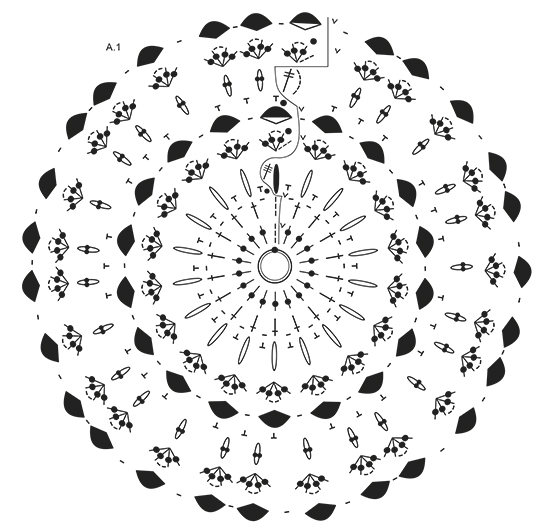
|
||||||||||||||||||||||||||||||||||||||||||||||

|
||||||||||||||||||||||||||||||||||||||||||||||
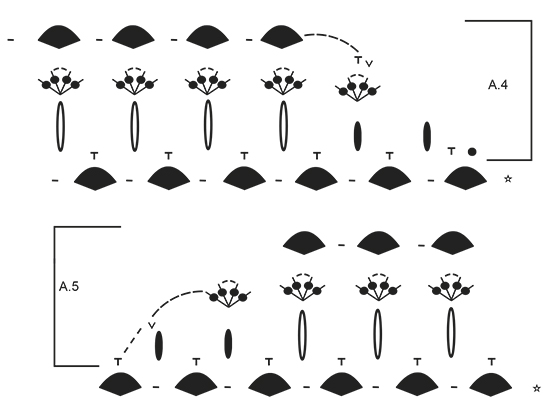
|
||||||||||||||||||||||||||||||||||||||||||||||
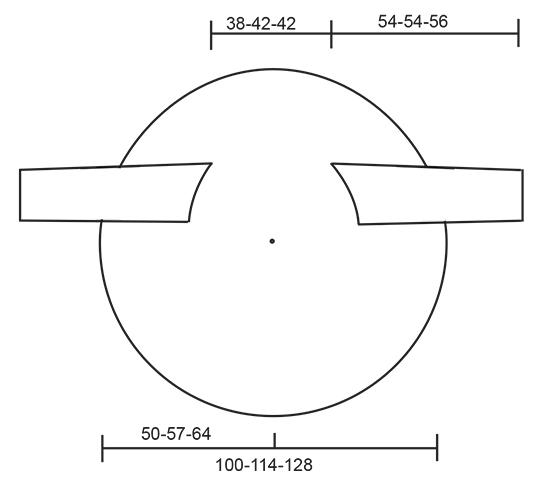
|
||||||||||||||||||||||||||||||||||||||||||||||
|
Have you made this or any other of our designs? Tag your pictures in social media with #dropsdesign so we can see them! Do you need help with this pattern?You'll find tutorial videos, a Comments/Questions area and more by visiting the pattern on garnstudio.com. © 1982-2024 DROPS Design A/S. We reserve all rights. This document, including all its sub-sections, has copyrights. Read more about what you can do with our patterns at the bottom of each pattern on our site. |
||||||||||||||||||||||||||||||||||||||||||||||








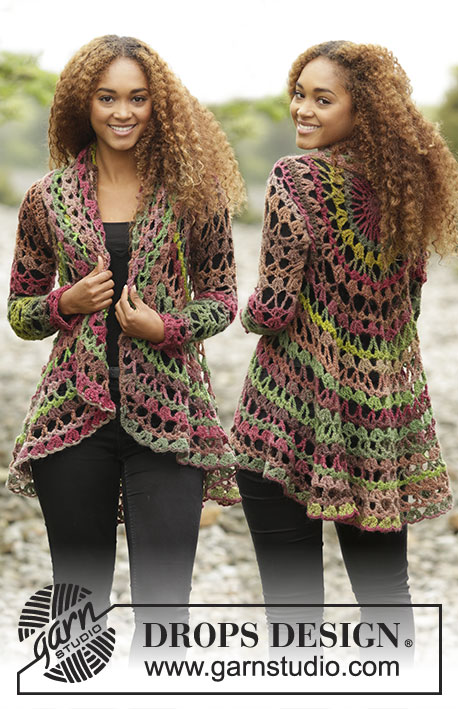
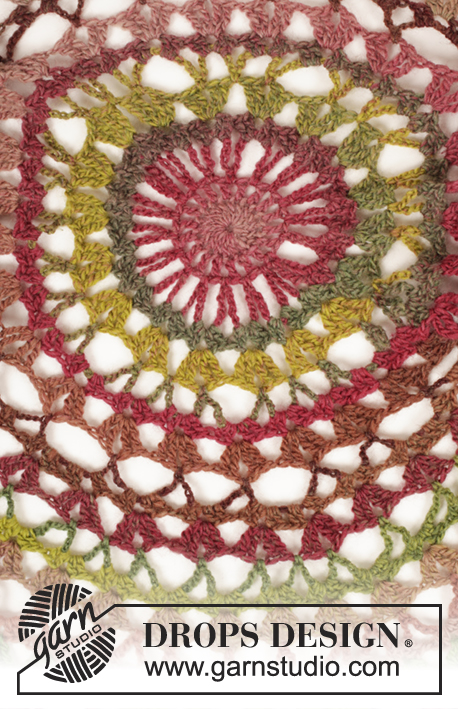


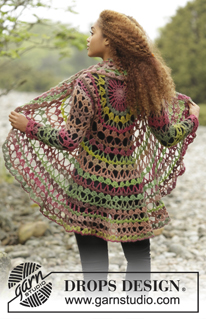
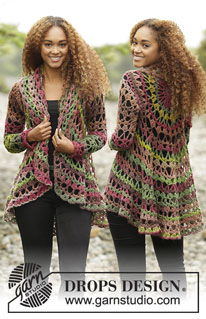


































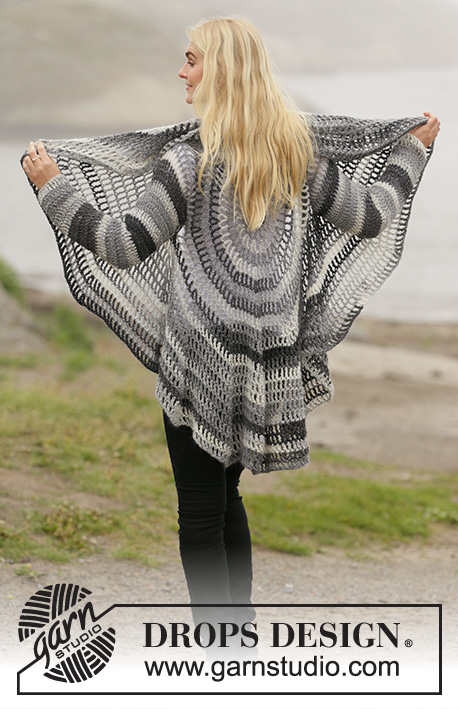







Comments / Questions (292)
Hej. Undrar om jag förstått mönstret rätt. Har gjort cirkeln och börjat med A3. När ärmhålen är gjorda finns det 8 resp 7 stolpgrupper emellan ärmhålen, stämmer det? Sedan står det att runt varje ärmhål (30 lm) ska det vara 6 stolpgrupper men att man ska öka 9 grupper jämnt över varvet. Ska det ökas över de 30 lm också eller enbart emellan?
02.09.2016 - 08:52DROPS Design answered:
Hej Eva. Ja, du öker jaevnt over hele varvet - saa jeg vil sige ogsaa over ärmhål
13.09.2016 - 14:40DANK JE WEL IK HEB HET BEGREPEN GROETJES Annie
01.09.2016 - 13:11Gelukkig kon ik dat 'zelf' bedenken, hartelijk dank zover en ik hoop als het nodig is weer met mijn vragen terecht te kunnen bij u! De service is top.
31.08.2016 - 13:57Ik begrijp het nu gelukkig. Maar toch nog een nieuwe vraag: in Tour zes moeten er toch steeds 9 lossen tussen die vasten? Dat is toch een en dezelfde Tour? Heel hartelijk dank.
30.08.2016 - 22:41DROPS Design answered:
Hoi Leny. Mooi. Ja, dat klopt - had ik gemist (9 l tussen de vasten op toer 6)
31.08.2016 - 11:57Hallo Hoe haak je het ovaal van vest herfstbos model nr. db 065. Het moet afwisselen met a4 en a5 maar ik weet niet hoe ik snap het niet benwel zover met het vest maar heb nog nooit geen patroon gelezen dus nu zit ik vast Annie
30.08.2016 - 16:29DROPS Design answered:
Hoi Annie. Je haakt toer 1-3 van A.3 totaal 2 keer langs de onderste 47-54-61 dstk-groepen en tegelijkertijd haak je volgens A.4 of A.5 bij het keren voor een mooie overgang. Vergeet niet om ook 7 l-lussen te meerderen elke keer dat je toer 1 van A.3 haakt (dwz, 2 keer 7 l-lussen meerderen).
01.09.2016 - 12:37Dank voor het antwoord, maar het is me nog niet duidelijk, het valt ook niet mee om duidelijk te omschrijven wat ik bedoel, mijn 'probleem' is dat ik om de 2 lossen van de stk.groep dus mijn 4 lossen heb gehaakt, moet dat dstk. daar dan in gehaakt worden? zo ja, dan daarna de 2 lossen en dan vouwt het geheel weer dubbel door het volgende dstk. wat ik wil haken. Ik voel me heel dom, maar ik kom er niet uit en ik wil zo graag dit vest maken. Help svp nog eens
29.08.2016 - 14:57DROPS Design answered:
Hoi Leny. Ik vind het moeilijk te volgen wat je bedoelt. Maar je begint met 4 l en dan haak je om de 2 l van de vorige toer: 1 dstk en 2 l en 2 dstk. Je haakt dan verder als volgt: 1 l, om de volgende 2 l van de vorige toer (kijk op telpatroon): 2 dstk en 2 l en 2 dstk om l-lus in stk-groep enzovoort. Je eindigt met 1 l en 1 hv in de 4e l van het begin van de toer. Kijk ook eventueel hier. Deze instructie is van mijn Franse collega. Misschien kan je wat mee.
30.08.2016 - 12:12Hoe moet ik tour vijf beginnen nadat ik de vier lossen heb gehaakt, ik moet dan een dubbel stokje maken en waar steek ik dat in? Dezelfde vraag is dan voor de volgende tour waar ik moet beginnen met twee dubbele stokjes. Alvast bedankt!
27.08.2016 - 16:31DROPS Design answered:
Hoi Leny. Je haakt de eerste "4 l, 1 dstk en 2 l en 2 dstk om l-lus in stk-groep" in de eerste 2 l tussen de stk-groep van vorige toer (zie telpatroon), daarna in toer 6 begin je met: haak hv tot midden van eerste l-lus, 1 l = dus hv over de 4 l tot het midden (ongeveer 2 hv verwacht ik), daarna ga je door met 1 v (de kleine T) in het midden van de l-lus, 1 v om de l tussen de dstk-groepen, 1 v om l-lus in dstk-groep enzovoort.
29.08.2016 - 11:46Another question because it said my first one was too long. Is there any way of getting a picture of this cardigan spread out flat? Are the edges of the oval blended into the circle?
26.08.2016 - 08:42DROPS Design answered:
Dear Belinda, there is no picture of the jacket flat, the oval shape is worked in rows, ie work on the stated number of sts for your size leaving the remaining sts unworked, the transition between circle (unworked sts) and A.4/A.5 will then be smooth and make a nice oval. Happy crocheting!
26.08.2016 - 11:04So I've made it to the oval portion of this pattern. I have read both the directions and looked at the diagrams. If I am reading the pattern correctly, it says to repeat A3 twice then do a group of A4 and finally a group of A5. But further down it says do an A4, then an A3, then an A5. I understand both ways, but which one do we do and how do we add the ch 12s at the beginning of the row?
26.08.2016 - 08:38DROPS Design answered:
Dear Melinda, when working A.4, A.3 and A.5, row 1 will start with first 2 6-ch-spaces (beg of A.4), then crochet 12-ch-spaces, then finish with 2 6-ch-spaces (end of A.5). Happy crocheting!
26.08.2016 - 11:02I am at the part where it says work A3 whick i did and increased 9 loops to end up with 45.round 2 and round 3.. then it says repeat 1-3 for 3 more times to end up with 72.. DO I just do 1 and 3 or do you mean 1,2,and 3?
25.08.2016 - 02:10DROPS Design answered:
Dear Mrs Smith, work the 3 rounds in A.3, ie round 1 inc 9 loops evenly, then round 2 and round 3, ie work A.3 that way a total of 4 times in height = there are 72 sts groups. Happy crocheting!
25.08.2016 - 10:09